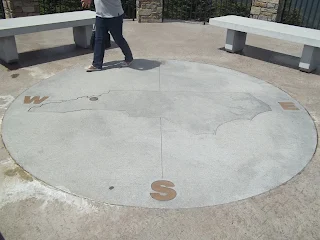To someone who lives outside of the American Southland, the Appalachian Mountains may not seem all that impressive. In terms of their sheer size, the tallest of the Appalachia's rounded peaks (over 5000+ feet) certainly do not compete with the 10-15,000+ foot peaks of the Rocky Mountains in western North America, or the Alps in Europe; and compared to the 20,000+ foot Andes in South America, or the high jagged peaks of the Himalayas in Asia, the Appalachians would probably not even register as medium sized hills.
The Appalachians themselves are the remnants of a very ancient mountain range - the Central Pangaean Mountains - that once stood as tall as the Andes or Himalayas and cut through the middle portion of the supercontinent Pangaea during the Triassic Period over 250-200 million year ago. The mountains themselves were formed when the continents themselves moved together between 475-250 million years ago.
What impresses me the most about the Appalachians is not their height.
What awes me about them is imagining the incredible forces beneath
the earth that it took to push billions of tons of earth and rocks
thousands of feet into the air, and then millions of years for nature to
smooth them out again. The idea of something so old that it existed from a time just before the rise of the dinosaurs of the Jurassic Period to the present day, let alone standing on those ancient peaks, is enough to remind this simple country writer from South Carolina just how small and insignificant we human beings really are compared to this grand old Earth of ours, as well as how short a period of time we as a species have been here.
As I mentioned before in my previous post on July 23rd, I was advised against taking certain actions out of concern for my well being by family and friends. It was advise I decided to take, and opted instead to listen to another calling; one that I had been longing to do a month or so before my birthday the month before, but had to put off for several weeks due to financial issues that were more important and needed to be dealt with.
As I mentioned before in my previous post on July 23rd, I was advised against taking certain actions out of concern for my well being by family and friends. It was advise I decided to take, and opted instead to listen to another calling; one that I had been longing to do a month or so before my birthday the month before, but had to put off for several weeks due to financial issues that were more important and needed to be dealt with.
So on Saturday, July 18th, your humble blogger - after weeks of feeling the mountains calling out to me - took the three hour trek from my home in South Carolina to the Southern Highlands and the Blue Ridge Parkway. My destination: Mt. Mitchell State Park in Yancey County, North Carolina.
At an elevation of 6,684 feet (2,037 m) above sea level, Mt. Mitchell is the highest peak in the Appalachian Mountains and the highest point east of the Mississippi River - literally the very top of Dixie (with the exception of several mountains in Texas).
The following are some of the photos I took along the Blue Ridge Parkway.
 |
| Passing through several tunnels along the Parkway. |
 |
| A quick summer storm can be seen coming up fast in the mountains. |
It was close to noon when I finally arrived at Mt. Mitchell State Park in the Pisgah National Forest.
 |
| Mt. Mitchell Mini Museum & Gift Shop. |
 |
| Here I am ready to take on the mountain trail. At this point I was already a mile above sea level. |
 |
| The summit of Mt. Mitchell. Highest peak in the eastern part of North America. |
 |
| The Summit Observation Tower And The Grave of Rev. Elisha Mitchell. |
 |
| On the way to the summit, I began to notice these small back bugs all over the place. A notice back at the mini museum and gift shop informed visitors that they were Weevils. |
These are the photos I took of the views in all four compass directions from the observation tower itself.
 |
| You are here. |
After taking photos and sitting down to enjoy the wonderful breezy weather at the top of the mountain - a good 15 degrees cooler than the 90+ down at sea level - and enjoying the turkey and cheese sandwich and bottled water I had for lunch, I then unpacked and unfurled my two American banners and posed while another traveler took several photos. One one of which actually caught both flags open at the same time.
I was of course asked about the flags by a couple of curious bystanders, particularly about why I choose to display the Dixie Cross banner. My answer was simply the truth. I brought both banners because I consider them both representative of my heritage and identity as an American and a Southerner by birthright. I also explained that I carry two banners with me whenever I conquer a trail and display them at any mountain peak I reach in victory.
I also had to confess that in this case I brought both banners and displayed them in solidarity with the tens of thousands of real Southern heritage advocates across Dixie who were taking stands at a hundred flag rallies in protest of the recent elevated attacks on symbols of Southern heritage, and in defense of the rights of individuals to honor who they are and where they came from without being judged or labeled for it.
I am pleased to report that my explanations were received in a positive way - particularly by a pair of aged Vietnam Veterans, both of whom knew men who carried the Dixie Cross banner with them overseas. They also offered my flags a salute, particularly the US flag with the black ribbon I tied around the top with the names of the five recently murdered US servicemen from Chattanooga, Tennessee a few days before. As always I shook their hands and thanked them for their services to the defense of our nation.
On my way back down the mountain to the gift shop I picked up a pair of souvenirs: a hiking medallion for my walking stick, and a new bumper sticker for my car. I on the way home at a service station getting a refill, I found a somewhat nifty little nick-knack for my collection that somehow seemed most appropriate.
 |
| My hat and walking stick. Note the collection of hiking medallions that designate the mountain peaks from across several Southern States where I've hiked to the summit. |
 |
| Hiked It. Liked It. My new bumper sticker....along with an older one. |
 |
| One of the enduring symbols of the Appalachians, a black bear, holding a Dixie Cross - another enduring symbol of the American Southland in spite of everything done to dishonor and do away with it. |
Overall, I found the experience of traveling to the Appalachian Mountains once again and conquering it's tallest peak - not to mention holding those two noble American banners out of both a sense of accomplishment and to send a positive message of solidarity with fellow Southerners and Americans - to have been a very rewarding one on a number of levels.
Standing up there at the highest point east of the Mississippi River and looking out at the amazing view of the remains of what was the first mountain range in this old world of ours, one feels a sense of awe that is hard to put into specific words. It's a connection that one feels on a deeply spiritual level that's a part of the land and a part of ourselves.
I do believe that finding that feeling and experiencing it while standing on the summit was worth the journey, and not just because the mountain was there to be hiked - although I have to admit the "because it's there" excuse is a pretty darned good one too.
Well, I hope y'all enjoyed this blog post. Be sure to write a comment below and as always safe travels, y'all!
Well, I hope y'all enjoyed this blog post. Be sure to write a comment below and as always safe travels, y'all!





















No comments:
Post a Comment